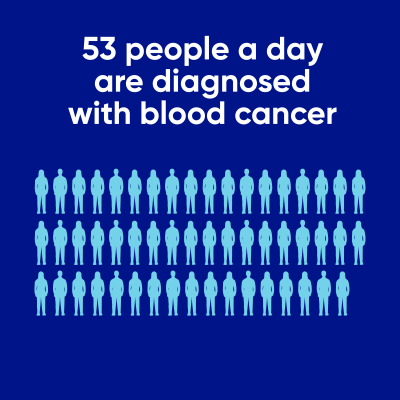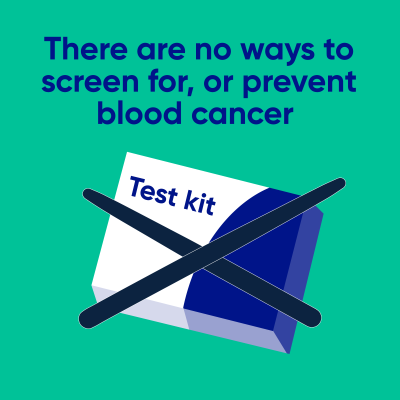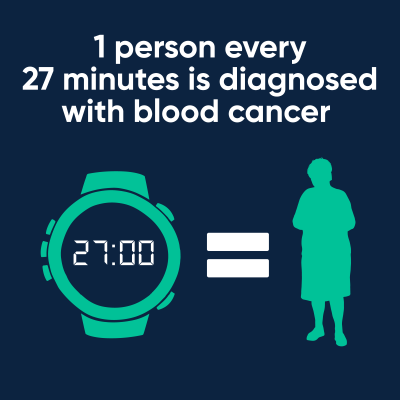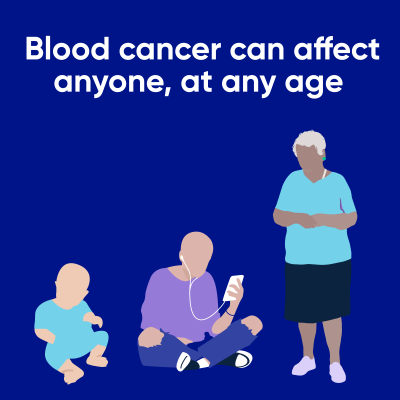Blood cancer facts and figures
The latest facts and statistics about blood cancer in Australia, as well as frequently asked questions.
0
people are living with blood cancer or a related blood disorder in Australia today.
0
people per day in Australia are expected to lose their life to blood cancer or related blood disorders.
0
Australians will be newly diagnosed with blood cancer such as leukaemia, lymphoma and myeloma every year.
Incidence + Prevalence:
- It is expected that 19,403 Australians will be newly diagnosed with blood cancer such as leukaemia, lymphoma and myeloma in 2022. This is equivalent to 53 people per day or one person every 27 minutes.
- Incidence of blood cancer continues to grow. Incidence of blood cancer has increased by 47% in the past 10 years.
- Around 135,000 people are living with a blood cancer or blood disorder in Australia today. By 2035, more than 275,000 Australians are expected to be living with a blood cancer or blood disorder.
Mortality:
- Over 5,950 people in Australia are expected to lose their life to blood cancer or related blood disorders this year. This is equivalent to 16 people per day.
Childhood Cancer:
- Acute lymphoblastic leukaemia is the most commonly diagnosed cancer in 0-14 year olds.
More blood cancer facts and statistics
Download the ‘Status of blood cancer in Australia 2022’ report here.
References
[i] https://www.aihw.gov.au/reports/cancer/cancer-data-in-australia/contents/summary
[ii] https://www.leukaemia.org.au/wp-content/uploads/2020/06/State-of-the-Nation-Blood-Cancer-in-Australia_Leukaemia-Foundation.pdf
Frequently asked questions
About the Leukaemia Foundation
What is the Leukaemia Foundation?
The Leukaemia Foundation is the only national charity dedicated to helping those with leukaemia, lymphoma, myeloma and related blood disorders survive and then live a better quality of life. Learn more about the work we do and how we support people living with blood cancer.
Where is the Leukaemia Foundation?
We have offices across Australia, with our head office located in Brisbane. For a full list of our accommodation centres, support offices, and administrative offices, click here.
What blood cancers and disorders does the Leukaemia Foundation offer services and support for?
The Leukaemia Foundation supports everyone with a blood cancer and related blood disorder. This list acknowledges some of the more prevalent blood cancers that our teams work with every day. Even if your diagnosis is not on this list, we’re here to help:
Leukaemia
Acute myeloid leukaemia (AML), Acute myelomonocytic leukaemia (AMML), Acute lymphoblastic leukaemia (ALL), Acute promyelocytic leukaemia (APML), Chronic myeloid leukaemia (CML), Chronic lymphocytic leukaemia (CLL), Richters syndrome, Hairy cell leukaemia, Biphenotypic leukaemia, Myeloid sarcoma (localised leukaemia).
Lymphoma (60+ sub-types, most common are listed)
Non-Hodgkin lymphoma B-Cell:
Follicular, Diffuse large B-cell (DLBCL), Burkitt’s, Mantle cell, Primary mediastinal B-cell (PMBCL), Primary cutaneous B-cell, Small lymphocytic (SLL), Marginal zone, MALT, Lymphoplasmacytic / Waldenstrom’s macroglobulinaemia (WM), Double hit (DHL).
T-Cell/NK-Cell:
Adult T-Cell leukaemic (ATLL), Anaplastic large cell (ALCL), Peripheral T-Cell , Cutaneous T-Cell, Mycosis fungoides, Śezary syndrome, Subcutaneous panniculitis-like T-Cell , T-Lymphoblastic, Hodgkin lymphoma, Nodular sclerosing HL, Mixed cellularity HL, Lymphocyte depleted HL, Lymphocyte rich HL, Nodular lymphocyte predominant HL.
Myeloma
Smouldering / indolent myeloma, IgG myeloma, IgA myeloma, Light chain myeloma, Monoclonal gammopathy of unknown significance (MGUS), Multiple myeloma, Plasmacytoma (localised myeloma), Osteosclerotic myeloma.
Myeloproliferative neoplasms
Essential thrombocythaemia (ET), Polycythaemia (Rubra) vera (PV), Myelofibrosis (MF), Chronic myelomonocytic leukaemia (CMML), Juvenile myelomonocytic leukaemia (JMML), Chronic neutrophilic leukaemia (CNL), Chronic eosinophilic leukaemia (CEL), Systemic mastocytosis (SM).
Myelodysplasia
Myelodysplastic syndrome (MDS), Refractory anaemia (RA), Myelodysplastic syndrome with del (5q) chromosome, Refractory anaemia with ringed sideroblasts (RARS), Refractory anaemia with excess blasts – type 1 (RAEB -1), Refractory anaemia with excess blasts – type 2 (RAEM-2), Refractory cytopenia with multilineage dysphasia (RCMD), Refractory cytopenia with multilineage dysplasia and ringed sideroblasts (RCMDRS).
Blood disorders
Aplastic anaemia (AA), Systemic mastocytosis, Paroxismal nocturnal haemoglobinuria.
Amyloidosis: AA – secondary amyloidosis, AL – systemic amyloidosis, ATTR – familial amyloidotic polyneuropathy, ATTR – wild type – senile amyloidosis, Afib – mutated fibrinogen alpha chain.
What’s a clinical trial?
A clinical trial is a research study that helps to determine whether a new drug or device is safe and effective. Each study is designed to answer questions and find better ways to screen, diagnose, prevent or treat a disease or condition. There’s more information about clinical trials here.
Is blood cancer common?
Blood cancer is one of the most commonly diagnosed cancers in Australia. There are no screening programs available and no way to prevent blood cancer through lifestyle changes. When combined, blood cancers are among the most frequently diagnosed cancers in the Australian community, and the most significant cause of non-preventable cancer death.
What’s the most common blood cancer?
Lymphoma is the most commonly diagnosed blood cancer in Australia, and the sixth most common form of cancer (ii).
How many people in Australia lose their lives to blood cancer?
Blood cancer is one of the highest causes of cancer death in Australia, claiming more lives than breast cancer (3,214, (iii) ) and melanoma (1,281) combined (iv). Over 5,950 people in Australia are expected to lose their life to blood cancer or related blood disorders in 2022. This is equivalent to 16 people per day in Australia.
Blood cancer basics
What is leukaemia?
Leukaemia is the general name given to a group of cancers that develop in the bone marrow. More information about leukaemia can be found here.
What is lymphoma?
Lymphoma is the general term for cancers that develop in the lymphatic system. More information about lymphoma can be found here.
What is blood cancer?
Blood cancer is a term that refers to cancers affecting the blood, bone marrow, and lymphatic system. Leukaemia, lymphoma, and myeloma are all blood cancers.
What’s the difference between non-Hodgkin lymphoma and Hodgkin lymphoma?
There are two main types of lymphoma: Hodgkin lymphoma and non-Hodgkin lymphoma. Hodgkin lymphoma is distinguished from all other types of lymphoma because of the presence, under the microscope, of a special kind of cancer cell called a Reed-Sternberg cell. The World Health Organisation currently recognises 43 sub-types of lymphoma. Five of these sub-types belong to a group of diseases called Hodgkin Lymphoma. All other sub-types are commonly grouped together and called non-Hodgkin Lymphomas.
What is MDS?
MDS is short for Myelodysplastic syndromes (myelodysplasia). This a group of diseases which affect the production of normal blood cells in the bone marrow. Find out more about MDS here.
What is ALL?
ALL is short for acute lymphoblastic leukaemia, a type of blood cancer. There are a few different types of ALL – find out more here.
Transplants
What’s a stem cell transplant?
Bone marrow and blood stem cell transplantation (commonly referred to as simply stem cell transplantation) is used to treat a range of diseases. In short, a stem cell transplant is necessary to ensure that the bone marrow is repopulated with healthy blood stem cells following high-dose treatment. The new blood stem cells will rebuild your body’s blood and immune systems.
References
(i) https://www.aihw.gov.au/reports/cancer/cancer-data-in-australia/contents/summary
(ii) https://www.aihw.gov.au/
(iii) https://www.aihw.gov.au/reports/cancer/cancer-data-in-australia/contents/summary
(iv) https://www.aihw.gov.au/reports/cancer/cancer-data-in-australia/contents/summary
(v) https://www.aihw.gov.au/reports/cancer/cancer-data-in-australia/contents/summary
Last updated on May 24th, 2024
Developed by the Leukaemia Foundation in consultation with people living with a blood cancer, Leukaemia Foundation support staff, haematology nursing staff and/or Australian clinical haematologists. This content is provided for information purposes only and we urge you to always seek advice from a registered health care professional for diagnosis, treatment and answers to your medical questions, including the suitability of a particular therapy, service, product or treatment in your circumstances. The Leukaemia Foundation shall not bear any liability for any person relying on the materials contained on this website.


